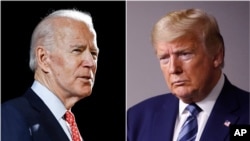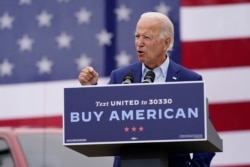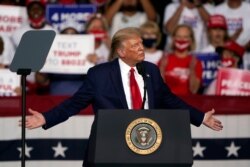While former Democratic Vice President Joe Biden has held a steady six or seven-point lead over President Donald Trump in the national public opinion polls, Trump has held one clear advantage over Biden — on the question of who voters believe is best suited to handle a troubled economy.
As recently as mid-August, a CNN poll indicated that 53% of voters believed Trump, the one-time New York real estate magnate, was the better candidate for economic issues, with 45% in the survey preferring Biden. But even that advantage has begun to dissipate. Just two weeks later, the same poll found Trump with a razor-thin 49% to 48% advantage. Other polling has shown a similar narrowing. Early September polling from CBS News and Quinnipiac showed a virtual tie in voters' beliefs about who would better handle the economy.
The reasons for the change are not completely clear, analysts say, but some of the movement is likely related to Biden taking a much more aggressive posture in challenging the president's handling of the economic fallout from the coronavirus pandemic.
While Trump has boasted that the 8.4 percent August unemployment rate was "much better than expected" and was down from the jaw-dropping 14.7 percent in April and 10.2 percent in July, the U.S. nonetheless is suffering historic economic hardship with roughly 14 million people out of work.
"We all know it didn't have to be this bad," Biden said in a fiery speech last week charging Trump with neglecting those most affected by the economic slowdown. "It didn't have to be this bad if the president just did his job."
Trump has relied on his go-to strategy of hyperbolic warnings of disaster if anybody but him is in the White House. In rally speeches and all-caps tweets, Trump regularly ties Biden to the most radical elements of the political left, claiming that a Biden presidency would usher in "socialism" and would lead to economic disaster.
Polling evidence can vary. The Economist/YouGov poll, conducted weekly, asks voters whether they believe the economy would get better or worse under Trump or Biden. In that poll, Trump's advantage had appeared to be shrinking, but polling out this week found that Trump has actually widened the gap. Of nearly 1,500 respondents, 39% said they believe the economy would improve under a second Trump term, while 38% believe it would get worse. The same poll found that 34% of respondents believe the economy would improve under Biden compared to 41% who said it would get worse.
From a big-picture perspective, the difference between the two candidates' economic policies breaks down along fairly predictable party lines. Trump offers Republican-friendly promises of more tax cuts and reduced regulations, while Biden offers a more traditional Democratic line, with higher taxes on the wealthy and businesses and increased government spending on infrastructure and social welfare. Both men are proposing measures to entice businesses to hire more workers in the U.S. rather than offshoring jobs to lower-wage countries.
Assessing the two candidates' economic visions at a more granular level is difficult, in part because of the difference in detail that the two campaigns have offered. The Biden campaign has put out dozens of detailed position papers on economic policy issues, replete with specific proposals and figures. The Trump campaign, by contrast, has issued a set of bullet points with general themes and few specifics.
Biden tax policy
Nowhere is this more apparent than in the area of tax policy — for both candidates arguably the most significant part of their economic agenda.
The Biden campaign has issued more than 50 specific proposals on taxes alone, and the former vice president's priorities are clear. He would raise the corporate tax rate to 28% from 21% and the top marginal income tax on individuals would go from 37% currently to 39.6%. Many of the tax increases the Biden campaign is proposing are tied to specific spending priorities, meant to fund things like expanded access to child care and major infrastructure projects.
An analysis of Biden's plans by the Tax Foundation, a leading independent tax policy nonprofit, found that over the coming decade, Biden's plans would raise federal tax receipts by approximately $4 trillion, or about 1.5% of Gross Domestic Product.
What Biden proposes would amount to a significant tax increase, but it is not, as Trump has repeatedly claimed, the largest in history. The rates Biden is proposing are also well within historical norms for the United States. And Biden says his tax hikes would target those making more than $400,000 a year.
"Joe Biden is looking to primarily raise taxes on higher earners," said Garrett Watson, a senior policy analyst at the Tax Foundation. "And that's through higher tax rates on ordinary income, on income coming from investments, and business income."
Trump tax policy
Trump signed a major Republican tax cut and jobs bill in 2017 and more recently proposed additional tax cuts as part of his second term agenda. Experts say the new plan is light on specifics, although in general it would expand existing tax breaks, create credits for specific industries, and unspecified tax cuts for individuals.
"We have far less information on the details and the specifics of the Trump tax plan," Watson said.
The lack of detail coming from the Trump campaign is a real stumbling block for those searching for a clear picture of what an economic future under a second Trump term would look like.
"For us as analysts, that provides a challenge," said Janet Holtzblatt, a senior fellow at the Urban-Brookings Tax Policy Center in Washington. While her organization has plans to release a comprehensive analysis of the Biden plan next month, she said developing one for Trump is proving difficult.
But the problem isn't just for policy analysts, she pointed out. "It's a challenge for voters who may be trying to compare the two plans."










